Papers by Sachiko Kinoshita

Journal of memory and language, 2013
Open bigram (OB) models (e.g., SERIOL: Whitney, 2001, 2008; Binary OB, Grainger & van Heuven, 200... more Open bigram (OB) models (e.g., SERIOL: Whitney, 2001, 2008; Binary OB, Grainger & van Heuven, 2003; Overlap OB, Grainger et al., 2006; Local combination detector model, Dehaene et al., 2005) posit that letter order in a word is coded by a set of ordered letter pairs. We report three experiments using bigram primes in the same-different match task, investigating the effects of order reversal and the number of letters intervening between the letters in the target. Reversed bigrams (e.g., fo-OF, ob-ABOLISH) produced robust priming, in direct contradiction to the assumption that letter order is coded by the presence of ordered letter pairs. Also in contradiction to the core assumption of current open bigram models, non-contiguous bigrams spanning three letters in the target (e.g., bs-ABOLISH) showed robust priming effects, equivalent in size to contiguous bigrams (e.g., bo-ABOLISH). These results question the role of open bigrams in coding letter order.

Journal of experimental psychology. General, 2008
The authors argue that perception is Bayesian inference based on accumulation of noisy evidence a... more The authors argue that perception is Bayesian inference based on accumulation of noisy evidence and that, in masked priming, the perceptual system is tricked into treating the prime and the target as a single object. Of the 2 algorithms considered for formalizing how the evidence sampled from a prime and target is combined, only 1 was shown to be consistent with the existing data from the visual word recognition literature. This algorithm was incorporated into the Bayesian Reader model (D. Norris, 2006), and its predictions were confirmed in 3 experiments. The experiments showed that the pattern of masked priming is not a fixed function of the relations between the prime and the target but can be changed radically by changing the task from lexical decision to a same-different judgment. Implications of the Bayesian framework of masked priming for unconscious cognition and visual masking are discussed.
Memory & Cognition, 2004
We examined the question of whether the sizes of the regularity and lexicality effects in naming ... more We examined the question of whether the sizes of the regularity and lexicality effects in naming can be modulated as a function of filler type (nonwords or low-frequency exception words). The lexicality effect was larger in the exception word filler condition than in the nonword filler condition, but the size of the regularity effect was essentially unaffected by filler type.
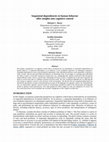
Integrated Models of Cognitive Systems, 2007
We present a perspective on cognitive control that is motivated by an examination of sequential d... more We present a perspective on cognitive control that is motivated by an examination of sequential dependencies in human behavior. A sequential dependency is an influence of one incidental experience on subsequent experience. Sequential dependencies arise in psychological experiments when individuals perform a task repeatedly or perform a series of tasks, and one task trial influences behavior on subsequent trials. For example, in a naming task, individuals are faster to name a word after having just named easy (e.g., orthographically regular) words than after having just named difficult words. And in a choice task, individuals are faster to press a response key if the same response was made on recent trials than if a different response had been made. We view sequential dependencies as reflecting the fine tuning of cognitive control to the structure of the environment. We discuss the two sequential phenomena just mentioned, and present accounts of the phenomena in terms of the adaptation of cognitive control. For each phenomenon, we characterize cognitive control in terms of constructing a predictive model of the environment and using this model to optimize future performance. This same perspective offers insight not only into adaptation of control, but how task instructions can be translated into an initial configuration of the cognitive architecture.
Language and Cognitive Processes, 2011
... b c , Manuel Carreiras a d e & Dennis Norris f pages 509-529. ... In Masked priming: Stat... more ... b c , Manuel Carreiras a d e & Dennis Norris f pages 509-529. ... In Masked priming: State of the art , Edited by: Kinoshita, S. and Lupker, SJ 279–305. Hove, , UK: Psychology Press. View all references; Rastle, Davis, & New, 200446. Rastle, K., Davis, MH and New, B. 2004. ...

The Quarterly Journal of Experimental Psychology, 2007
Two experiments investigated whether priming due to a match in just the onset between a masked pr... more Two experiments investigated whether priming due to a match in just the onset between a masked prime and target is found with high-frequency target words. Forster and Davis (1991, Exp. 5) reported that the masked onset priming effect was absent for high-frequency words and used the finding to argue that the effect has its locus in the grapheme-phoneme mapping process that operates serially within the nonlexical route. Experiment 1 used primes that were unrelated to targets and found a masked onset priming effect of equal size for high-frequency and low-frequency target words. Experiment 2 used form-related primes as used by Forster and Davis, and again found that the effect of onset mismatch was not dependent on target word frequency. These results are interpreted in terms of an alternative view that the masked onset priming effect has its origin in the process of preparing a speech response.

The Quarterly Journal of Experimental Psychology, 2010
In the same-different match task, masked priming is observed with the same responses but not diff... more In the same-different match task, masked priming is observed with the same responses but not different responses. Norris and Kinoshita's (2008) Bayesian reader account of masked priming explains this pattern based on the same principle as that explaining the absence of priming for nonwords in the lexical decision task. The pattern of priming follows from the way the model makes optimal decisions in the two tasks; priming does not depend on first activating the prime and then the target. An alternative explanation is in terms of a bias towards responding "same" that exactly counters the facilitatory effect of lexical access. The present study tested these two views by varying both the degree to which the prime predicts the response and the visibility of the prime. Unmasked primes produced effects expected from the view that priming is influenced by the degree to which the prime predicts the response. In contrast, with masked primes, the size of priming for the same response was completely unaffected by predictability. These results rule out response bias as an explanation of the absence of masked priming for different responses and, in turn, indicate that masked priming is not a consequence of automatic lexical access of the prime.
Psychonomic Bulletin & Review, 1999
In the classical Stroop effect, response times for naming the colour in which a word is printed a... more In the classical Stroop effect, response times for naming the colour in which a word is printed are affected by the presence of semantic, phonological or orthographic relationships between the stimulus word and the response word. We show that colour naming responses are faster when the printed word shares a phoneme with the colour name to be produced than when it does not, in conditions where there is no semantic relationship between the printed word and the colour name. This result is compatible with a variety of computational models of reading. However, we also found that these effects are much larger when it is the first phoneme that the stimulus and response share than when it is the last.
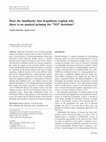
Memory & Cognition, 2011
Traditional "activation" views of masked priming explain the identity priming effect in terms of ... more Traditional "activation" views of masked priming explain the identity priming effect in terms of facilitation due to 'pre-activation' of stored representations. Norris and Kinoshita's (2008) Bayesian Reader theory of masked priming instead explains priming in terms of the evidence that the prime contributes towards the decision required to the target. In support of the Bayesian Reader account, Norris and Kinoshita showed that the absence of priming for nonwords in the lexical decision task and for targets requiring a Different decision in the same-different match task can be explained based on a single principle. Against this, Bowers (2010) argued that the absence of priming should be explained instead by a combination of sublexical priming and "familiarity bias". As evidence, Bowers cited Bodner and finding that nonword priming did emerge with targets presented in visually unfamiliar cAsE-AlTeRnAtEd format. We present evidence that this finding was due to the use of an ambiguous letter in casealternated format; when using unambiguous letters, we consistently failed to find priming of case-alternated nonwords. We suggest that the Bayesian Reader, rather than the familiarity bias hypothesis, explains the absence of priming.
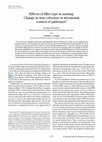
Memory & Cognition, 2002
We report two naming experiments examining the effects of filler type on the size of regularity a... more We report two naming experiments examining the effects of filler type on the size of regularity and frequency effects.Low-frequency exception words were used as one filler type in both experiments. Their effects were contrasted with the effects of nonword fillers (Experiment 1) and low-frequency regular word fillers (Experiment 2). In both experiments, the size of the regularityeffect was unaffected by the filler type manipulation. In contrast, the frequency effect interacted with filler type such that relative to the low-frequency exception filler environment, the size of the frequency effect was reduced in the environment of low frequency regular word fillers, but not in the environment of nonword fillers. These results appear to be better explained in terms of Lupker, Brown, and Colombo's (1997) flexible timecriterion framework than in terms of a pathway control hypothesis (e.g., .
Language and Cognitive Processes, 2009
We investigated how transposed-letter (TL) priming effects are modulated by neighbourhood density... more We investigated how transposed-letter (TL) priming effects are modulated by neighbourhood density in lexical decision task and cross-case same-different task. Robust identity priming and TL priming effects were observed in both tasks. Neighbourhood density facilitated ' ...
Journal of Memory and Language, 2010
Early on during word recognition, letter positions are not accurately coded. Evidence for this co... more Early on during word recognition, letter positions are not accurately coded. Evidence for this comes from transposed-letter (TL) priming effects, in which letter strings generated by transposing two adjacent letters (e.g., jugde) produce large priming effects, more than primes with the letters replaced in the corresponding position (e.g., junpe).
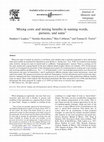
Journal of Memory and Language, 2003
When two types of stimuli are mixed in a trial block, each stimulus type is typically responded t... more When two types of stimuli are mixed in a trial block, each stimulus type is typically responded to more slowly than when those stimuli are presented by themselves in pure blocks (a ''mixing cost,'' Los, 1996). In word/non-word naming tasks, however, mixing two types of stimuli leads to a different, ''homogenization,'' pattern. There is a mixing cost for the easier stimuli and a mixing benefit for the more difficult stimuli . In the present research we investigated the generality of this homogenization pattern by examining picture naming and a sum-naming task involving addition problems (e.g., 10+7 ¼ ?). In Experiments 1 and 2, the homogenization pattern was observed for both pictures and sums. In Experiments 3 and 4, qualitatively different stimulus types (words and pictures, words and sums) were mixed. The mixing cost pattern was observed. Experiments 5 (words and pictures) and 6 (words and sums), however, demonstrated that a homogenization-type pattern can be obtained even when qualitatively different stimulus types are mixed. These results indicate that theoretical mechanisms like those proposed by and theoretical mechanisms like those proposed by are both active in reaction time experiments.
Journal of Experimental Psychology: Learning, Memory, and Cognition, 2011
European Journal of Cognitive Psychology, 2010
Bowers (2010) presented a critique of the account of masked priming presented by Norris and Kinos... more Bowers (2010) presented a critique of the account of masked priming presented by Norris and Kinoshita (2008) based on the Bayesian Reader model of visual word recognition (Norris, 2006). In this reply, we point out that: (1) Bowers' criticisms are based on his misunderstanding of both the Bayesian or ideal-observer approach, and the theoretical claims made in Norris and Kinoshita,

Frontiers in Psychology, 2012
A method used widely to study the first 250 ms of visual word recognition is masked priming: Thes... more A method used widely to study the first 250 ms of visual word recognition is masked priming: These studies have yielded a rich set of data concerning the processes involved in recognizing letters and words. In these studies, there is an implicit assumption that the early processes in word recognition tapped by masked priming are automatic, and masked priming effects should therefore be invariant across tasks. Contrary to this assumption, masked priming effects are modulated by the task goal: For example, only word targets show priming in the lexical decision task, but both words and non-words do in the same-different task; semantic priming effects are generally weak in the lexical decision task but are robust in the semantic categorization task. We explain how such task dependence arises within the Bayesian Reader account of masked priming (Norris and Kinoshita, 2008), and how the task dissociations can be used to understand the early processes in lexical access.

Cognition, 2008
Masked repetition primes produce greater facilitation in naming in a block containing a high, rat... more Masked repetition primes produce greater facilitation in naming in a block containing a high, rather than low proportion of repetition trials. . Beyond binary judgments: Prime-validity modulates masked repetition priming in the naming task. Memory & Cognition, 32, 1-11] suggested this phenomenon reflects a strategic shift in the use of masked prime as a function of its validity. We propose an alternative explanation based on the Adaptation to the statistics of the environment (ASE) framework, which suggests the proportion effect reflects adaptation of response-initiation processes to recent trial difficulty. Consistent with ASE's prediction, (1) stimuli that produce the proportion effect also produced an ''asymmetric blocking effect'', showing a smaller fall in response latencies of hard items than the rise of easy items when the two item types were intermixed 0010-0277/$ -see front matter Ó
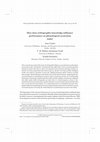
The Quarterly Journal of Experimental Psychology: Section A, 2003
Three experiments explored the nature of orthographic influences on performance on phonological a... more Three experiments explored the nature of orthographic influences on performance on phonological awareness tasks. Experiment 1 demonstrated that adults find it easier to perform phoneme deletions on items where there is a direct correspondence between letters and target sounds (e.g., take the /r@/ from struggle) than where there is not (e.g., take the /w@/ from squabble). Analogous results were found in a phoneme reversal task. Spelling production ability tended to correlate more strongly with performance on the former type of item than on the latter, suggesting that elevated performance on phonological awareness tasks is associated with the use of orthographic information. Experiment 2 produced similar results in Grade 5 children. Experiment 3 suggested that adults cannot inhibit orthographic activation when it is disadvantageous to them, as they performed no better on items such as squabble when they were presented in pure blocks than when they were presented in mixed blocks. It is concluded that there are substantial automatic orthographic influences on phonological awareness task performance that need to be taken into account in interpreting data concerning the relationship between phonological awareness and reading.










Uploads
Papers by Sachiko Kinoshita